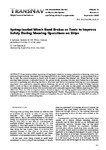Spring-loaded Winch Band Brakes as Tools to Improve Safety During Mooring Operations on Ships

View/
Use this link to cite
http://hdl.handle.net/2183/26949Collections
Metadata
Show full item recordTitle
Spring-loaded Winch Band Brakes as Tools to Improve Safety During Mooring Operations on ShipsDate
2020-09Citation
Iglesias-Baniela S., Pérez-Canosa J.M., Cid-Bacorelle D.: Spring-loaded Winch Band Brakes as Tools to Improve Safety During Mooring Operations on Ships. TransNav, the International Journal on Marine Navigation and Safety of Sea Transportation, Vol. 14, No. 3, doi:10.12716/1001.14.03.25, pp. 711-719, 2020
Abstract
[Abstract] Some recent accident reports involving large vessels in mooring operations or breaking away from their moorings conclude that brakes of mooring winches do not render before line parts. As the potential loss of life is high, the utmost attention on-board must be paid to minimise this inherent risk. When the load on the mooring lines becomes overloaded beyond the pre-set levels, mooring winches band brakes have the safety function of rendering and allowing the line to shed this load before its potential breaking and the subsequent snap-back. As a preventive measure against breaking, the pre-set level, known as Brake Holding Capacity (BHC), must be below the Minimum Breaking Load (MBL) of the line. In this paper, the authors analyse concerns that can arise from those with conventional screw manually-applied band brakes regarding their BHC reliability. Thus, in order to improve safety, the advantages of the spring-applied band brakes with manual setting and release or with hydraulic release are highlighted. Finally, the paper shows a typical procedure using a hydraulic jack for brake testing the winch of a Liquefied Natural Gas (LNG) ship to fix their BHC in order to hold 60% of the MBL of the mooring line.
Keywords
Amarre de barcos
Cabrestante de amarre
Frenos de banda
Medidas de seguridad
Cabrestante de amarre
Frenos de banda
Medidas de seguridad
Editor version
Rights
Atribución-NoComercial 3.0
ISSN
2083-6473






